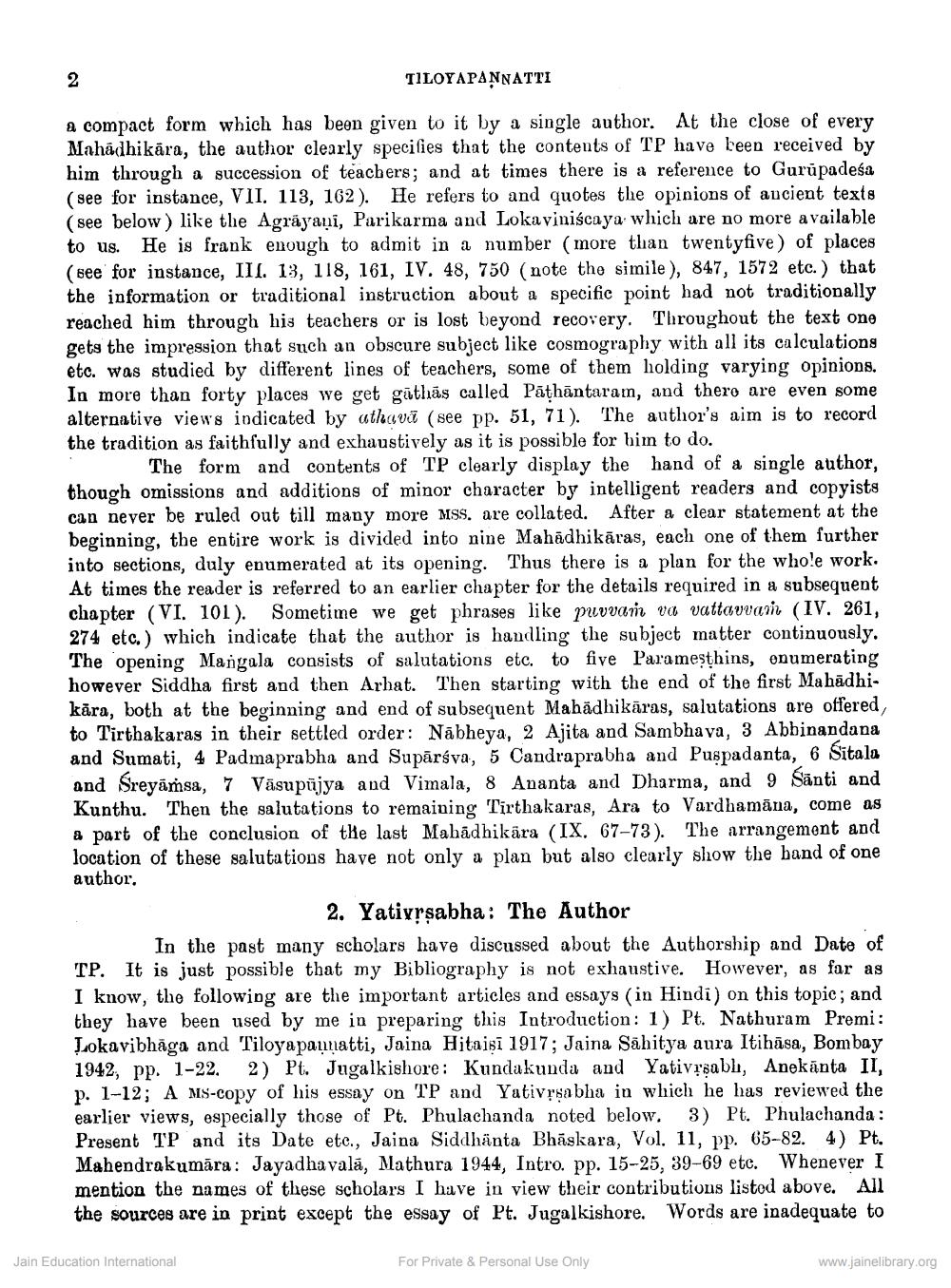________________
TILOYAPANNATTI
a compact form which has been given to it by a single author. At the close of every Mahādhikāra, the author clearly specifies that the contents of TP have been received by him through a succession of teachers; and at times there is a reference to Gurupadesa (see for instance, VII. 113, 162). He refers to and quotes the opinions of aucient texts (see below) like the Agrāyani, Parikarma and Lokaviniscaya which are no more available to us. He is frank enough to admit in a number (more than twentyfive) of places (see for instance, III, 13, 118, 161, IV. 48, 750 (note the simile), 847, 1572 etc.) that the information or traditional instruction about a specific point had not traditionally reached him through his teachers or is lost beyond recovery. Throughout the text one gets the impression that such an obscure subject like cosmography with all its calculations etc. was studied by different lines of teachers, some of them holding varying opinions. In more than forty places we get gathās called Pāķhāntaram, and thero are even some alternative views indicated by uthavē (see pp. 51, 71). The author's aim is to record the tradition as faithfully and exhaustively as it is possible for him to do.
The form and contents of TP clearly display the hand of a single author, though omissions and additions of minor character by intelligent readers and copyists can never be ruled out till many more Mss. are collated. After a clear statement at the beginning, the entire work is divided into nine Mahādhikāras, each one of them further into sections, duly enumerated at its opening. Thus there is a plan for the whole work. At times the reader is referred to an earlier chapter for the details required in a subsequent chapter (VI. 101). Sometime we get phrases like puvvar va vattavvar (IV. 261, 274 etc.) which indicate that the author is handling the subject matter continuously. The opening Mangala consists of salutations etc. to five Parameșthins, enumerating however Siddha first and then Arhat. Then starting with the end of the first Mahādhikāra, both at the beginning and end of subsequent Mahādhikāras, salutations are offered to Tirthakaras in their settled order: Nābheya, 2 Ajita and Sambhava, 3 Abbinandana and Sumati, 4 Padmaprabha and Supārśva, 5 Candraprabha and Puspadanta, 6 Sitala and Sreyāṁsa, 7 Väsupūjya and Vimala, 8 Ananta and Dharma, and 9 Sānti and Kunthu. Then the salutations to remaining Tirthakaras, Ara to Vardhamāna, come as a part of the conclusion of the last Mahādhikāra (IX. 67-73). The arrangement and location of these salutations have not only a plan but also clearly show the band of one author,
2. Yativrsabha: The Author In the past many scholars have discussed about the Authorship and Date of TP. It is just possible that my Bibliography is not exhaustive. However, as far as I know, the following are the important articles and essays (in Hindi) on this topic; and they have been used by me in preparing this Introduction: 1) Pt. Nathuram Premi: Lokavibhāga and Tiloya paunatti, Jaina Hitaisi 1917; Jaina Sahitya aura Itihāsa, Bombay 1942, pp. 1-22. 2) Pt. Jugalkishore: Kundakunda and Yativrsabl, Anekānta II, p. 1-12; A MS-copy of his essay on TP and Yativrsabha in which he has reviewed the earlier views, especially those of Pt. Phulachanda noted below. 3) Pt. Phulachanda : Present TP and its Date etc., Jaina Siddhänta Bhāskara, Vol. 11, pp. 65-82.4) Pt. Mahendrakumāra: Jayadha vală, Mathura 1944, Intro. pp. 15-25, 39-69 etc. Whenever I mention the names of these scholars I have in view their contributions listed above. All the sources are in print except the essay of Pt. Jugalkishore. Words are inadequate to
Jain Education International
For Private & Personal Use Only
www.jainelibrary.org




